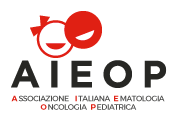MEET AIEOP’S WORKING GROUPS!
Each week we will be featuring two of AIEOP’s 29 Working Groups and their coordinators as an opportunity for the international medical community to get to know them and their important work!
Meet the Adolescent Working Group
&
Coordinator Andrea Ferrari

As Coordinator of the working group, tell us a little bit about its history?
The AIEOP Adolescent Working Group was founded in 2020; however, its history began well before, when the first AIEOP Commission dedicated to adolescents was created in 2007. In those years, little was known about the problems for adolescent and young adult patients (AYA), and there was no specific literature on the subject. The first data on the survival gap of AYA patients were beginning to emerge, somewhat neglected by the international cancer community, in addition to difficulties in accessing centers of excellence and limited inclusion in clinical protocols. The AIEOP Commission was immediately very active, promoting clinical studies and communication initiatives and placing itself in the forefront of the international scene, interacting within Europe, as well as North America and Japan. In parallel, a particular sensitivity grew within the AIEOP centers for the more global aspects of the lives of sick children.
With the idea that a crucial aspect for the care of AYA patients was interacting with the adult oncology world, the AIEOP Commission ahead of time founded the SIAMO project in 2013-2014, an acronym that initially stood for “Società Italiana Adolescenti con Malattie Onco-ematologiche” (Italian Society Adolescents with Onco-haematological Diseases) and which was later changed to the” Italian Scientific Societies Together for Adolescents with Onco-haematological Diseases”. SIAMO with the fundamental support of FIAGOP, managed to obtain the official patronage of the Ministry of Health and promoted numerous initiatives, including the collaboration with the Umberto Veronesi Foundation. Although considered an international model, SIAMO was unable to achieve a significant interaction with the scientific societies of adult onco-hematology, so in June 2018 the project was closed. However, a second was created that later became the WG, which resumed the path and was successful in promoting and finalizing the collaboration with the Italian Association of Medical Oncology.
What is the overall aim of the WG as well as what is a current goal?
We told ourselves several times in our WG that our aim is to try to define the best approach for treating adolescent patients with onco-haematological diseases, starting directly from the patients’ needs: “what is best for them”. The specific objectives are many, from addressing the problem of the gap between observed and expected cases in AIEOP centers and enrollment in clinical protocols, to supporting the recognition of the complexity of interdisciplinary care of patients in this age group, which must be centered on the individual’s life and expressed in clinical-care organizations and dedicated projects.
Our work intersects with the AIOM-AIEOP Working Group, which has defined a list of objectives that include communication and education activities, research projects and the development of clinical recommendations. A complex and ambitious goal is to define the structural and functional characteristics that a center must have in order to care for adolescent and young adult patients with cancer and thus to create a network in the national territory and the institutional recognition of the group.
It becomes even more complex by the close interaction of our WG and the AIOM-AIEOP Group with the various international projects, in which various members of the WG have central roles: the SIOPE AYA Committee (SIOPE is the European Society for Pediatric Oncology), the ESMO/SIOPE AYA Working Group (ESMO is the European Society for Medical Oncology) and the ENTYAC (European Network for Teenagers and Young Adults with Cancer) project; or even projects such as STRONG-AYA or JANE (Joint Action on Networks of Expertise).
What has been your WG’s greatest accomplishment?
I believe there are several aspects to underline. Certainly being able to structure a collaboration with adult oncologist colleagues was a moment of extraordinary value. It was important to believe in it, to persevere, and to find the right people who believe in the same idea.
International recognition is another crucial moment, without which it is difficult to really change things. From there comes the possibility of creating a manifesto shared by European scientific societies, such as the ESMO/SIOPE position paper, or the possibility of influencing the European Parliament at the Public Hearing of the Special Committee on Beating Cancer.
It is nice to see how things have changed at our AIEOP centers in recent years since the AIEOP Adolescent Commission was created. We have gone from a time when only 10% of children between 15 and 19 years old were treated in our centers, to 40% of adolescents having access (with age limits abolished in most centers). Until ten years ago there were only two projects dedicated to adolescents in AIEOP (in Aviano and Milan), today over twenty AIEOP centers have specific projects.
However, the most important recognition for all of us are the smiles on the children’s faces, their eyes, their stories, sharing their stories at events or to the various projects that AIEOP centers carry out locally. They allow us to understand that the road is long, but it is the correct one.
What message do you have to the international medical community or what is your hope for the future of your field of work globally?
The message, and at the same time the hope, is to come to understand the importance of listening to our patients. They are the ones who tell us what they need. They tell us every day that they need – of course the right treatment protocols – but doctors who are capable of listening and directly hearing from them what their needs, fears and hopes are. The rest (the care protocols, the shared projects, the European networks) comes from there.

